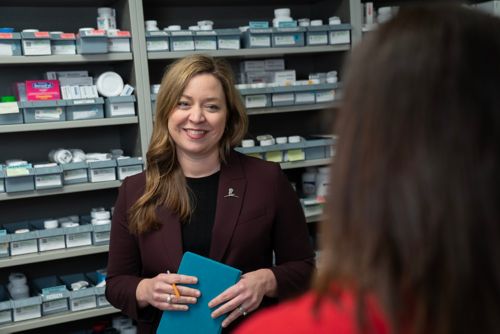St. Jude Family of Websites
Explore our cutting edge research, world-class patient care, career opportunities and more.
St. Jude Children's Research Hospital Home

- Fundraising
St. Jude Family of Websites
Explore our cutting edge research, world-class patient care, career opportunities and more.
St. Jude Children's Research Hospital Home

- Fundraising
Personalized, palatable, precise: Transforming pediatric medication delivery

By 3D printing medicines, the St. Jude Department of Pharmacy & Pharmaceutical Sciences is providing more drug formulation options, making them easier for pediatric patients to take.
There is a subtle art to getting a child to take their medicine — part science, part sleight of hand. A little applesauce, a quick distraction, a reassuring smile. For decades, families and clinicians have relied on rituals, tricks and some bargaining or persuasion to unite what is necessary with what is palatable.
But what if medicine itself could be reimagined? What if the formulation was not something to disguise, but something designed with the patient in mind from the start? Or even with the patients’ input along the way?
The challenges of pediatric medication administration have persisted through generations, largely due to the limitations of traditional drug formulations and delivery systems. Tablets and capsules are often difficult for children to swallow. Liquids may taste unpleasant or be inconsistently measured, leading to dosing errors. And while pharmacists have long bridged these gaps through extemporaneous compounding, the process remains time-intensive and inherently variable.
In recent years, a new frontier has emerged, combining pharmacy practice with technological innovation. At St. Jude, this future is closer than ever. The hospital is on track to become the first United States institution to introduce semi-autonomous and 3D pharmaceutical compounding for direct patient care. By embracing automation, customization and precision, this approach has the potential to reshape how we think about pediatric medication delivery — not just here, but across the field of pediatric health care.
“This is a problem we’ve always wanted to solve,” said Brooke Bernhardt, PharmD, chief pharmacy officer, Department of Pharmacy & Pharmaceutical Sciences. “It’s exciting because this will address so many pain points and hopefully improve care and clinical outcomes.”

Brooke Bernhardt, PharmD, St. Jude Chief Pharmacy Officer, points out how 3D printing will reduce pain points for pharmacists while enabling better patient care.
Reimagining medicine for children
Already in use across Europe, these technologies offer a novel approach to creating medications that are easier to administer. This 3D printing technology can produce medications in various child-friendly forms, such as dissolving films, mini-tabs, troches (medicated lozenges) and gummy tablets. There are also flavor options that make medicines more palatable.
A recent feasibility study published by Bernhardt and colleagues in the journal Pharmaceutics explored how this works in practice, using the automated compounding platform to produce customized hydrocortisone formulations for pediatric patients.
Three dosage forms were prepared to demonstrate the system’s versatility in matching patient needs for different strengths and types. Analytical testing of the 3.2 mg gel tablets, 2.8 mg water-free troches and 1.2 mg orodispersible films (rapidly dissolving films that do not require water for swallowing) each met standards for mass and content uniformity.
“This ensures we get the right dose in the right formulation and hopefully in a format that is more suitable and palatable for patients of all ages, including those with special medical needs,” Bernhardt said.
A new era of automation and customization
St. Jude has three new 3D printers, two of which will operate in a newly remodeled laboratory to house the technology. Palatability testing is underway, with potency and stability testing coming in the fall. Full implementation is expected shortly thereafter, marking a pivotal moment in pediatric health care.
Once fully implemented, the automated technology is expected to enhance accuracy and quality control by minimizing human error, ensuring that each dose is precisely prepared. Additionally, medications can be customized to account for various patient factors such as age, genetics, allergies and disabilities.
This level of customization may ultimately lead to better patient outcomes, fewer medication errors and improved medication adherence. For pediatric patients at St. Jude, the introduction of 3D-printed medications means greater availability of personalized treatments. Children will benefit from medications that are not only more effective but also less burdensome to take. This improvement can lead to better adherence to medication regimens, ultimately improving health outcomes.
As this new system takes shape, it signals something larger than just a technological upgrade. It reflects the institutional commitment to forward-thinking care, meeting children not just where they are medically, but developmentally, behaviorally and emotionally. If medications are easier to take, more precise in dose and tailored to the individual, then we move closer to the kind of medicine that does not just treat but also empowers. It is one more way St. Jude is pushing toward a future where innovation serves the most vulnerable patients with care, accuracy and compassion.






